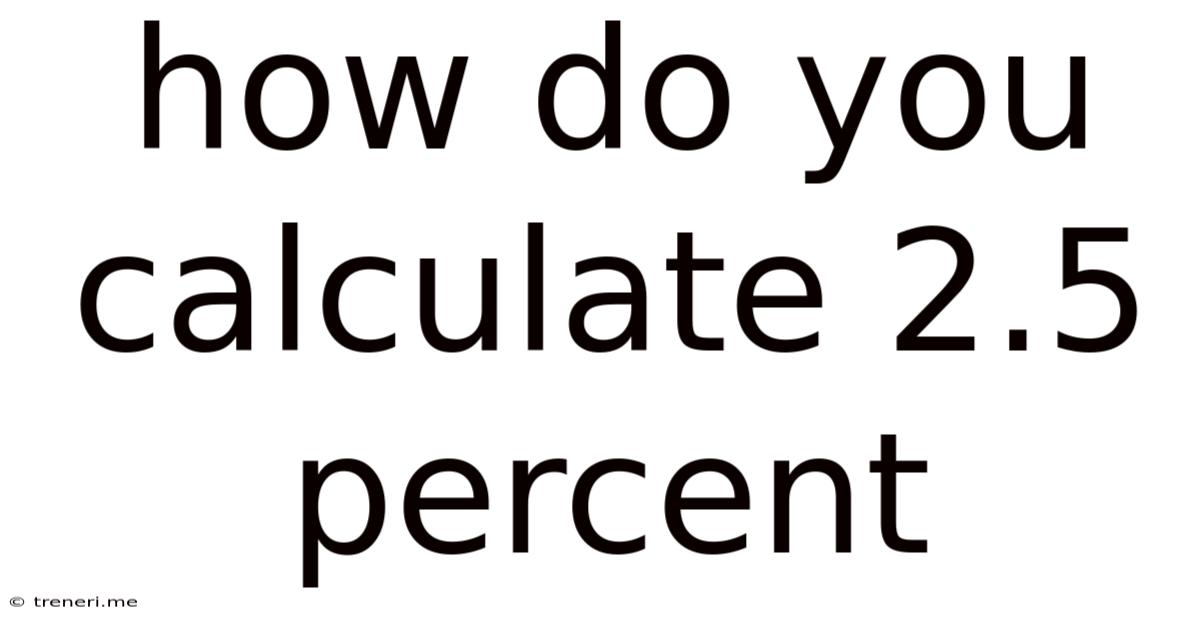How Do You Calculate 2.5 Percent
Treneri
May 10, 2025 · 4 min read

Table of Contents
How Do You Calculate 2.5 Percent? A Comprehensive Guide
Calculating percentages is a fundamental skill with applications across various fields, from finance and budgeting to sales and statistics. While calculating simple percentages like 10% or 50% is straightforward, understanding how to calculate more nuanced percentages, such as 2.5%, requires a clear understanding of the underlying principles. This comprehensive guide will walk you through multiple methods of calculating 2.5% of a number, explaining the process step-by-step and providing practical examples. We'll also explore the broader context of percentage calculations and their real-world applications.
Understanding Percentages
Before diving into the calculation of 2.5%, let's refresh our understanding of percentages. A percentage is a fraction expressed as a part of 100. The symbol "%" represents "per hundred" or "out of 100". For example, 50% means 50 out of 100, or 50/100, which simplifies to 1/2 or 0.5.
This simple concept forms the basis for all percentage calculations. To calculate a percentage of a number, we essentially convert the percentage into a decimal and then multiply it by the number.
Method 1: Converting Percentage to Decimal
This is the most common and straightforward method for calculating 2.5% of a number. The process involves these steps:
-
Convert the percentage to a decimal: To convert 2.5% to a decimal, divide it by 100: 2.5 / 100 = 0.025
-
Multiply the decimal by the number: Let's say we want to find 2.5% of 200. We multiply the decimal (0.025) by the number (200): 0.025 * 200 = 5
Therefore, 2.5% of 200 is 5.
Example Scenarios:
-
Calculating Sales Tax: If a product costs $100 and the sales tax is 2.5%, the sales tax amount would be 0.025 * $100 = $2.50.
-
Determining a Discount: A store offers a 2.5% discount on a $500 item. The discount amount would be 0.025 * $500 = $12.50. The final price would be $500 - $12.50 = $487.50.
-
Calculating Interest: If you have a savings account with a 2.5% annual interest rate and a balance of $1000, your interest earned in one year would be 0.025 * $1000 = $25.
Method 2: Using Fractions
Alternatively, you can calculate 2.5% using fractions. This method provides a deeper understanding of the underlying mathematical principles:
-
Express the percentage as a fraction: 2.5% can be written as 2.5/100. To simplify this fraction, we can multiply both the numerator and denominator by 10 to get rid of the decimal: (2.5 * 10) / (100 * 10) = 25/1000. This fraction can be further simplified to 1/40.
-
Multiply the fraction by the number: Let's again use the example of finding 2.5% of 200. We multiply 1/40 by 200: (1/40) * 200 = 200/40 = 5.
This confirms that 2.5% of 200 is 5, consistent with the result obtained using the decimal method.
Method 3: Using a Calculator
Most calculators have a percentage function (%) that simplifies the calculation. Here's how to use it:
-
Enter the number: Input the number you want to find 2.5% of (e.g., 200).
-
Multiply by 2.5: Multiply the number by 2.5.
-
Press the percentage button (%): This automatically divides the result by 100, giving you the final answer.
Practical Applications of 2.5% Calculations
Understanding how to calculate 2.5% is crucial in various real-world situations:
-
Finance: Calculating interest rates on loans, mortgages, or savings accounts. Determining investment returns and understanding compound interest. Analyzing financial statements and assessing profitability margins.
-
Retail: Calculating discounts, sales tax, and profit margins. Analyzing sales data and forecasting future revenue. Determining pricing strategies.
-
Healthcare: Understanding dosage calculations, particularly in medication administration. Analyzing healthcare statistics and identifying trends.
-
Science and Engineering: Performing calculations involving percentages in experimental data analysis. Understanding error margins and statistical significance.
Beyond 2.5%: Calculating Other Percentages
The methods outlined above can be easily adapted to calculate any percentage. Simply replace 2.5% with the desired percentage and follow the same steps. For instance:
-
Calculating 15%: Convert 15% to a decimal (0.15) and multiply it by the number.
-
Calculating 0.75%: Convert 0.75% to a decimal (0.0075) and multiply it by the number.
Troubleshooting Common Mistakes
While calculating percentages might seem straightforward, several common mistakes can lead to inaccurate results:
-
Incorrect decimal conversion: Ensure you correctly convert the percentage to a decimal before multiplying. A misplaced decimal point can drastically alter the result.
-
Order of operations: Follow the correct order of operations (PEMDAS/BODMAS) if you're performing multiple calculations.
-
Using the wrong percentage: Double-check that you're using the correct percentage in your calculations.
Conclusion
Calculating 2.5% (or any percentage) is a fundamental mathematical skill with widespread applications. By understanding the underlying principles and employing the various methods outlined in this guide – decimal conversion, fraction method, and calculator usage – you can confidently tackle percentage calculations in various contexts. Remember to practice regularly to build proficiency and avoid common mistakes. Mastering percentage calculations empowers you to analyze data, make informed decisions, and confidently navigate numerical challenges in your personal and professional life.
Latest Posts
Latest Posts
-
How To Know How Much Muscle You Have
May 11, 2025
-
What Is A 1 4 Oz In Grams
May 11, 2025
-
How Many Km Is 30 Minutes Driving
May 11, 2025
-
Cuanto Es 80 Gramos En Cucharadas
May 11, 2025
-
41 8 As A Mixed Number
May 11, 2025
Related Post
Thank you for visiting our website which covers about How Do You Calculate 2.5 Percent . We hope the information provided has been useful to you. Feel free to contact us if you have any questions or need further assistance. See you next time and don't miss to bookmark.